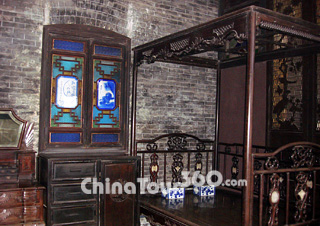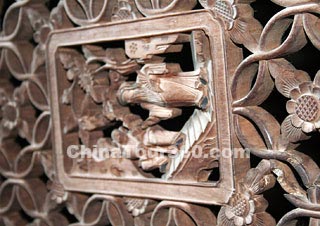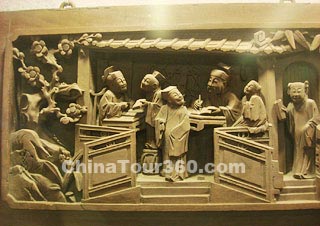Ancient Chinese furniture has a nice reputation in modern China and the West alike, since ancient furniture features profound cultural facts and superb craftsmanship. Chinese furniture, mostly made of precious wood, of the Ming (1368 - 1644) and Qing (1644 - 1911) dynasties are widely recognized as the best, because the wooden crafts before the Ming Dynasty did not survive wars and time and traditional Chinese furniture craftsmanship reached its zenith until the Ming dynasty when demand for fine furniture greatly increased due to prosperity of cities and development of the commodity economy and growing marine trade so that precious timber could be more easily obtained form southern China and Southeast Asia. It reached a high level of aesthetic success and could even claim a place in the history of world furniture.

An Arhat Bed of the Qing Dynasty
Chinese furniture was usually lacquered red or black and then painted, and often carved and sometimes inlaid with other materials such as precious stones, etc.
Furniture of the Ming Dynasty is known for its simplicity with sparse lines and little decoration while that of the Qing Dynasty emphasizes detail and extravagance. Furniture from southern China tends to be very elaborate whereas northern furniture is big, heavy and grand.
|
|
Ming Dynasty Furniture: It is simple with sparse lines and little decoration. It usually features fine and durable precious woods, such as Mahogany, sandalwood and rose wood etc. In the Ming dynasty, the demand for fine furniture, the ample supply of wood and the highly developed tenon-mortise technology all facilitated the success of the Ming furniture. Craftsmen of the Ming Dynasty used the succinct language of art to express their inner feelings, and combined ingeniously the beauty of simplicity and quietness. So the Ming furniture usually has simple structures, unique shapes and minimal decorations which would reserve the natural beauty of the wood. Lines were ingeniously applied to emphasize details such as the back of an armchair and the legs and resting bars of chairs and tables. Main emphasis was placed on the application of the natural beauty of the wood texture and adopting latticework and openwork carving. On eye-striking places such as the backs of armchairs, there would be simple patterns by relief engraving or openwork carving.
Qing Dynasty Furniture: In the early Qing Dynasty, furniture inherited characteristics of the Ming dynasty. From the reign of Emperor Yongzheng to Emperor Jiaqing, after political power was stabilized and the economy improved, people began to pay more attention to their material lives and demanded decorative and luxurious furnishings so that gaudiness and sumptuousness are basic features of Qing furniture, which is usually heavy, sizable and massive, and features exquisitely carved patterns. Some pieces were carved from head to foot and had inlays of stone, mother-of-pearl, porcelain, metal, and enamel. Qing furniture's curved decorations and exaggerated shapes demand attention.









